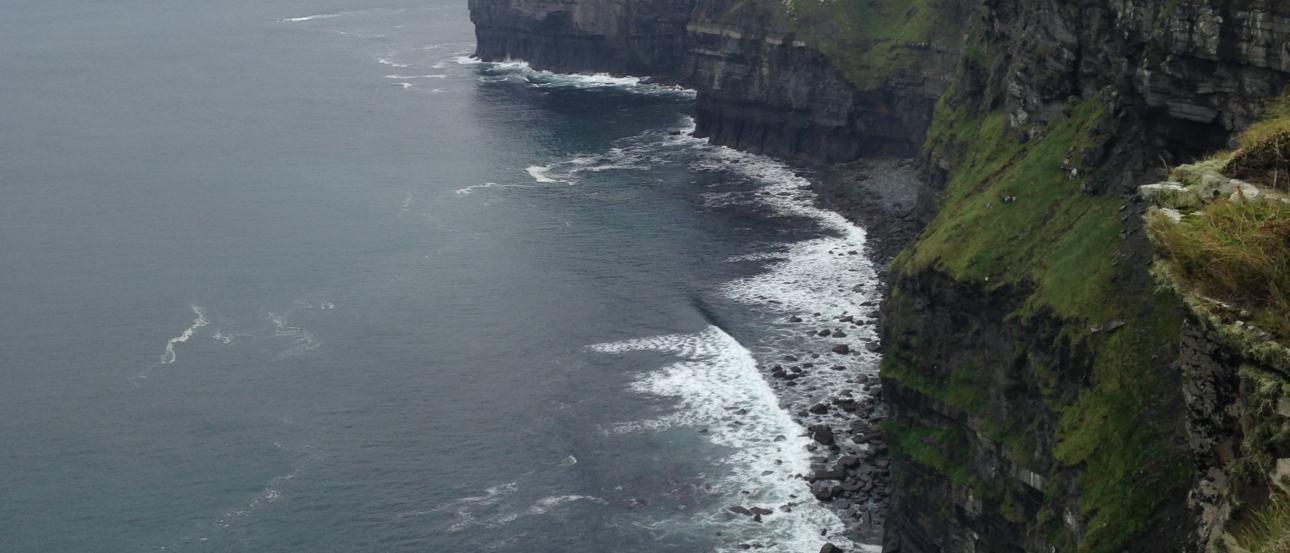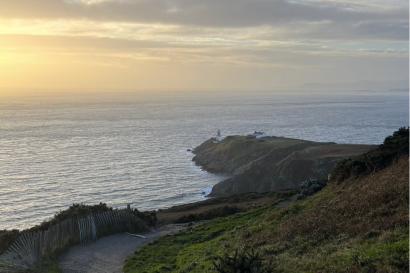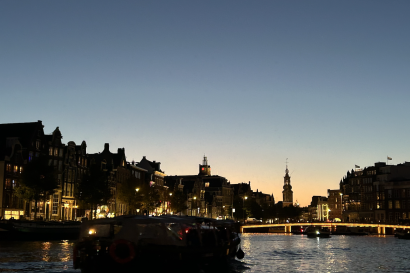“Jesus, Chelsea,” my friend Danny says when I stretch my left leg out behind me, pointing my toes backwards and extending my arms wide like the ballerina I have never been. I quit dance lessons in elementary school. “Will you stop that?”
I just laugh. He’s annoyed, I know, not because of the sheer inelegance of my unpractised arabesque, but because of the sheer impropriety of it. We are standing atop the Cliffs of Moher, the great craggy rock faces on the western shore of Ireland that jut out sharply over the Atlantic before plummeting down into it in a manner that is almost perfectly perpendicular. At the very moment that I balance myself, we are somewhere between 390 and 702 feet above sea level, but only five or six feet from what might be called the supremely elevated shoreline, with no guardrail to cushion us, nothing to check us if we fell. So all in all, caution makes sense here. It would be all too easy for me, or any one of the five people I’ve come here with, to make one false step and teeter over the edge, to fall downward into the depths, never to be heard from again.
But I laugh, anyway, because Danny’s exclamation catches me by surprise, because I feel so unafraid, atop those rocks, so utterly alive, without even a whisper of consciousness of the reverse. The deep darkness of the rocks stunned me when I first saw them; the Cliffs stand out sharply against the dull blues and greys of the cloudy sky. But if these rocks look so utterly uncompromising, so utterly unyielding, they don’t feel so. Indeed, carpeted as they are in a thick quilting of long mossy grasses, they feel sponge-like beneath my feet, lending a bounce to my step that propels me upwards even as I direct my feet downwards. Even the cold sea breeze and the light drops of salty precipitation in the air around me are enlivening, though ordinarily, I’m the first to shiver when a cold front comes, when the raindrops fall.
It is only when I sit still for a moment on that rocky ledge and pull a notebook and pencil out of my bag, letting the rest of my friends wander on, that I begin to feel a little uneasy. Hanging there, over the edge, I find I am only capable of producing the sparsest, most unconnected sentences about what I see and how it makes me feel. The empty page, more than the empty air, unsettles me.
But I push these thoughts away when my friend Sarah calls to me from the next bluff: “Keep writing! We’re going to go look at the cows!”
“No,” I say, shutting the notebook and leaping to my feet. “I’ll come!” The big, sad eyes and long, lolling tongues of the cows make me forget any fears. By the time we return to the cliff edges, I find myself once again compelled toward them. Sarah and I cast wildflowers into the ocean below, while Danny continues to repeat his exhortations that the pair of us cut it out.
So when I am on the Cliffs, my interaction with them is sensory and emotional and not intellectual. I see dark rocks and white foam, listen to the ocean rush and the waves break, feel miniscule water droplets and long, soft grass. I hardly give a thought about what any of it says about fear or fearlessness, much less beauty or bravery. It’s only the next day that these questions start to percolate. The following morning, when my four friends and I gather in the cottage kitchen to fill our plates with a breakfast of brown bread toast and scrambled eggs and strawberry jam, the conversation turns to the Cliffs, and somewhere in the midst of those words, I begin to wonder what bravery is, and what is means, and if it has anything to do with a pile of rocks, however daunting, however high.
Danny says that it does. As he opens a jar of peanut butter, he suggests that the Cliffs of Moher might just be a very apt metaphor for life: terrible and fearsome and even, perhaps, deadly, but despite all that, or maybe because of it, one of the most beautiful, awesome things he's ever seen. I want to agree, to say that they are, indeed, one of the most beautiful, awesome things I’ve ever seen. I felt them to be so. But I can’t think them to be so, at least not according to the contours of his contention. I can’t say that I found them very scary. I can’t say that they made me afraid.
This does not make me feel superior. Indeed, if there’s anything that stays with me over the next few days, as I start to philosophize the Cliffs, to think of them in terms other than rock and grass and sky and feeling, it’s the fact that I have no idea what being brave means, much less how I can be it. This is all the more problematic because of the niggling sense the Cliffs give me that the brave has something to do with the beautiful. How can I ever hope to be a writer, if I don’t know how to be adventurous? How can I ever hope to be a writer, if I can’t recognize beauty?

Chelsea Thomeer
I'm a rising junior at Williams College majoring in English and political science. I love reading and running, Jane Austen and J.K. Rowling, pumpkin bread and pretzels, The Grapes of Wrath and green tea. I'm spending a semester in Ireland to study Irish literature and to work on my own writing.








